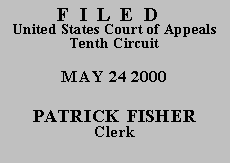

| UNITED STATES OF AMERICA, | No. 99-7152
(D.C. No. 99-CV-90-S) |
Richardson pleaded guilty to one count of conspiring to possess with intent to distribute cocaine in violation of 21 U.S.C. § 846. See United States v. Richardson, No. 95-7009, 1996 WL 34401, at **1 (10th Cir. Jan. 30, 1996). This Court subsequently dismissed his appeal for lack of jurisdiction because the challenged sentencing decision was not reviewable. See id. at **2. Richardson did not file a petition for a writ of certiorari with the Supreme Court. On March 4, 1999, he filed the instant § 2255 motion in federal district court.
On April 24, 1996, the Antiterrorism and Effective Death Penalty Act of 1996 ("AEDPA") became effective, including the provision subjecting § 2255 motions to a one-year statute of limitations:
A 1-year period of limitation shall apply to a motion under [28 U.S.C. § 2255]. The limitation period shall run from the latest of
(1) the date on which the judgment of conviction becomes final;
(2) the date on which the impediment to making a motion created by governmental action in violation of the Constitution or laws of the United States is removed, if the movant was prevented from making a motion by such governmental action;
(3) the date on which the right asserted was initially recognized by the Supreme Court, if that right has been newly recognized by the Supreme Court and made retroactively applicable to cases on collateral review; or
(4) the date on which the facts supporting the claim or claims presented could have been discovered through the exercise of due diligence.
28 U.S.C. § 2255. If a defendant does not file a petition for a writ of certiorari with the United States Supreme Court after a direct appeal, the judgment of conviction is final when the time for filing a certiorari petition expires. United States v. Burch, 202 F.3d 1274, 1276 (10th Cir. 2000).
We dismissed Richardson's direct appeal on January 30, 1996, and he did not file a petition for a writ of certiorari. His conviction thus became final on April 30, 1996, when the ninety-day period for filing such a petition expired. See Sup. Ct. R. 13.1 (providing that a petition for a writ of certiorari is timely when it is filed within ninety days following the entry of judgment).(1) Because the one-year limitations period expired on April 29, 1997, Richardson's March 4, 1999, § 2255 motion was untimely.
Recognizing his procedural default, Richardson argues that he is entitled to equitable tolling of the limitations period because he did not have notice of AEDPA's new one-year limitations period, his poverty prevented him from retaining an attorney, and he suffers from a learning disability. While § 2255 provides for three situations in which the limitations period will begin to run after a conviction becomes final, none apply to Richardson's proffered justifications. Nor do those justifications present "extraordinary circumstances" warranting equitable tolling. United States v. Willis, 202 F.3d 1279, 1281 n.3 (10th Cir. 2000) (citing Miller v. Marr, 141 F.3d 976, 978 (10th Cir. 1998)). First, the argument that he had no notice of AEDPA's new limitations period is without merit: AEDPA became effective before Richardson's conviction became final, and therefore its time limit was the only one that ever applied to his case. Second, his poverty, sadly, is unexceptional. Third, Richardson offers no explanation as to why his alleged learning disability prevented him from filing his § 2255 motion within one year, let alone nearly three years, of the date his conviction became final.
The request for a certificate of appealability is DENIED.
The mandate shall issue forthwith.
ENTERED FOR THE COURT
Carlos F. Lucero
Circuit Judge
*.The case is unanimously ordered submitted without oral argument pursuant to Fed. R. App. P. 34(a)(2) and 10th Cir. R. 34.1(G). This order and judgment is not binding precedent, except under the doctrines of law of the case, res judicata, and collateral estoppel. The court generally disfavors the citation of orders and judgments; nevertheless, an order and judgment may be cited under the terms and conditions of 10th Cir. R. 36.3.
1. As a point of clarification, "[t]he time to file a petition for a writ of certiorari runs from the date of entry of the judgment or order sought to be reviewed, and not from the issuance of the mandate." Sup. Ct. R. 13.3.